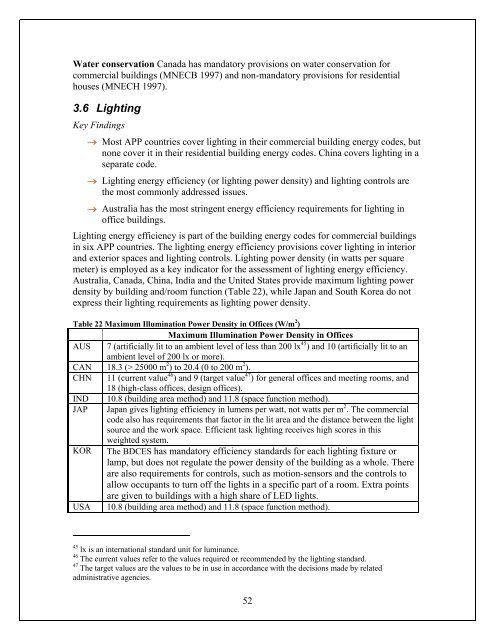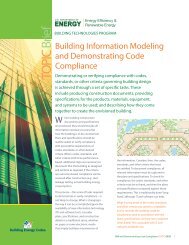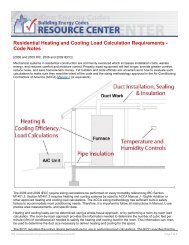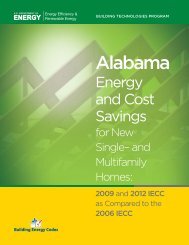Shaping the Energy Efficiency in New Buildings - Building Energy ...
Shaping the Energy Efficiency in New Buildings - Building Energy ...
Shaping the Energy Efficiency in New Buildings - Building Energy ...
You also want an ePaper? Increase the reach of your titles
YUMPU automatically turns print PDFs into web optimized ePapers that Google loves.
Water conservation Canada has mandatory provisions on water conservation forcommercial build<strong>in</strong>gs (MNECB 1997) and non-mandatory provisions for residentialhouses (MNECH 1997).3.6 Light<strong>in</strong>gKey F<strong>in</strong>d<strong>in</strong>gs Most APP countries cover light<strong>in</strong>g <strong>in</strong> <strong>the</strong>ir commercial build<strong>in</strong>g energy codes, butnone cover it <strong>in</strong> <strong>the</strong>ir residential build<strong>in</strong>g energy codes. Ch<strong>in</strong>a covers light<strong>in</strong>g <strong>in</strong> aseparate code. Light<strong>in</strong>g energy efficiency (or light<strong>in</strong>g power density) and light<strong>in</strong>g controls are<strong>the</strong> most commonly addressed issues. Australia has <strong>the</strong> most str<strong>in</strong>gent energy efficiency requirements for light<strong>in</strong>g <strong>in</strong>office build<strong>in</strong>gs.Light<strong>in</strong>g energy efficiency is part of <strong>the</strong> build<strong>in</strong>g energy codes for commercial build<strong>in</strong>gs<strong>in</strong> six APP countries. The light<strong>in</strong>g energy efficiency provisions cover light<strong>in</strong>g <strong>in</strong> <strong>in</strong>teriorand exterior spaces and light<strong>in</strong>g controls. Light<strong>in</strong>g power density (<strong>in</strong> watts per squaremeter) is employed as a key <strong>in</strong>dicator for <strong>the</strong> assessment of light<strong>in</strong>g energy efficiency.Australia, Canada, Ch<strong>in</strong>a, India and <strong>the</strong> United States provide maximum light<strong>in</strong>g powerdensity by build<strong>in</strong>g and/room function (Table 22), while Japan and South Korea do notexpress <strong>the</strong>ir light<strong>in</strong>g requirements as light<strong>in</strong>g power density.Table 22 Maximum Illum<strong>in</strong>ation Power Density <strong>in</strong> Offices (W/m 2 )Maximum Illum<strong>in</strong>ation Power Density <strong>in</strong> OfficesAUS 7 (artificially lit to an ambient level of less than 200 lx 45 ) and 10 (artificially lit to anambient level of 200 lx or more).CAN 18.3 (> 25000 m 2 ) to 20.4 (0 to 200 m 2 ).CHN 11 (current value 46 ) and 9 (target value 47 ) for general offices and meet<strong>in</strong>g rooms, and18 (high-class offices, design offices).IND 10.8 (build<strong>in</strong>g area method) and 11.8 (space function method).JAP Japan gives light<strong>in</strong>g efficiency <strong>in</strong> lumens per watt, not watts per m 2 . The commercialcode also has requirements that factor <strong>in</strong> <strong>the</strong> lit area and <strong>the</strong> distance between <strong>the</strong> lightsource and <strong>the</strong> work space. Efficient task light<strong>in</strong>g receives high scores <strong>in</strong> thisweighted system.KOR The BDCES has mandatory efficiency standards for each light<strong>in</strong>g fixture orlamp, but does not regulate <strong>the</strong> power density of <strong>the</strong> build<strong>in</strong>g as a whole. Thereare also requirements for controls, such as motion-sensors and <strong>the</strong> controls toallow occupants to turn off <strong>the</strong> lights <strong>in</strong> a specific part of a room. Extra po<strong>in</strong>tsare given to build<strong>in</strong>gs with a high share of LED lights.USA 10.8 (build<strong>in</strong>g area method) and 11.8 (space function method).45 lx is an <strong>in</strong>ternational standard unit for lum<strong>in</strong>ance.46 The current values refer to <strong>the</strong> values required or recommended by <strong>the</strong> light<strong>in</strong>g standard.47 The target values are <strong>the</strong> values to be <strong>in</strong> use <strong>in</strong> accordance with <strong>the</strong> decisions made by relatedadm<strong>in</strong>istrative agencies.52
















